Fusarium head blight control in wheat
Reducing productivity and responsible for the production of mycotoxins that are harmful to human health, FHB is an aggressive fungal disease in wheat crops.
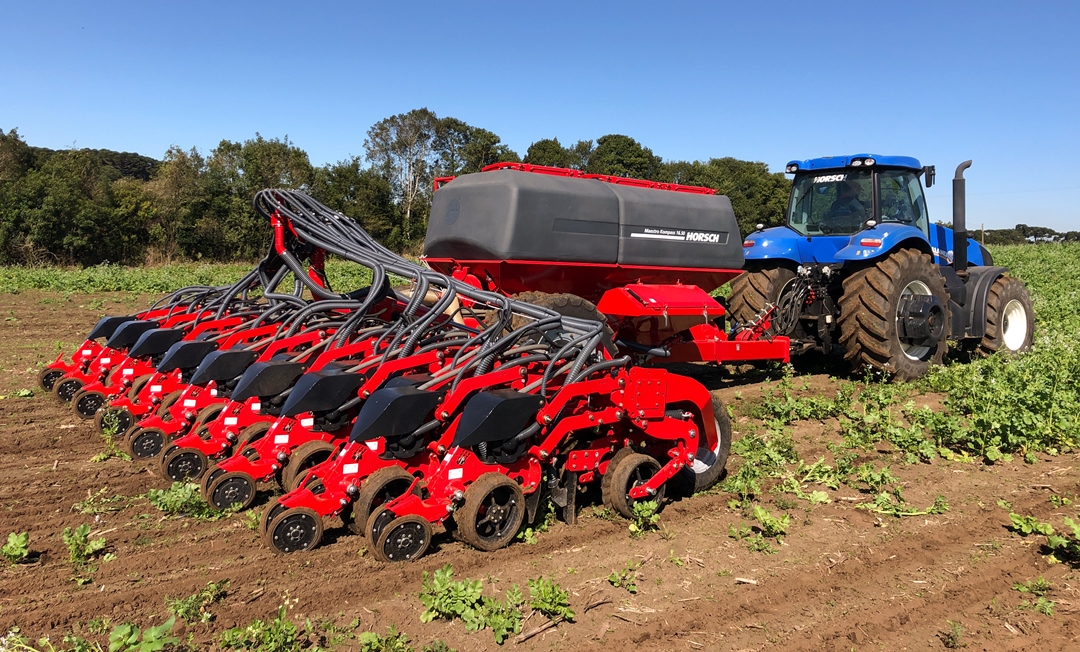
The Maestro Kompass 16.50 is a seeder-fertilizer that combines technology from the larger models designed by HORSCH in Germany, with specific solutions for direct planting conditions in Brazil
The excellent conditions offered for knowledge and evaluation of the machine in the field made this evaluation with the HORSCH seeder-fertilizer, model Maestro Kompass 16.50, a different test. The team from Revista Cultivar Máquinas and the Agrotechnology Laboratory of the Agricultural Machinery Testing Center at UFSM went to the city of Fazenda Rio Grande, specifically at the Gralha Azul Experimental Farm, in the metropolitan region of Curitiba, to test the 16-inch model. lines spaced 50cm apart. The Gralha Azul Experimental Farm belongs to the Pontifical Catholic University of Paraná and serves as an experimental area and practical classes for undergraduate and postgraduate courses in rural areas. With an area of approximately 200 hectares, there are experiments with annual plants, fruit trees and animals. In a partnership with PUCPR, HORSCH carries out practical training activities for customers, employees and the dealer network.
The Kompass is a machine with Brazilian DNA, as it only exists in the HORSCH portfolio for the national market. It was created based on models originating in Germany, but developed and tested based on a joint project with producers from the state of Paraná. This machine is not offered for the European market, because it has devices particularly developed for the specificities of our direct straw planting system.
In relation to the other models offered by HORSCH for the Brazilian market, the Maestro Evolution and the Maestro Duo, the Maestro Kompass is a smaller machine, because while the Evolution can be offered from 24 to 40 lines, the Duo from 24 to 36 lines, Kompass ranges from 14 to 18 lines, with spacings of 45cm to 50cm, as chosen by the customer at the time of purchase.
Although it is a machine for many applications, this model fills, in the HORSCH portfolio, a space dedicated to direct planting crops in Brazil, mainly in the states of the South region, which have medium-sized areas and are prevented or difficult to use machines. of large dimensions, especially serving producers who use the fertilization process at the time of sowing and with the presence of a large amount of straw on the surface.
The machine has a central structure and a planting bar, divided into two sections that articulate, collapsing for transport. The tractor coupling system is similar to that fitted to other Maestro models, including a safety chain, which protects machines and workers in the event of disengagement from the drawbar. Also attached to the structure, there is a support foot (jack) that assists coupling and serves as support for the stopped machine.
On the chassis side members, we have a support for counterweights that serve to maintain the longitudinal balance of the machine. In the central position of the chassis, we have a robust support for the two fertilizer and seed tanks. The one at the front is used for fertilizer and has a capacity of 4.500 liters, while at the back there is a seed tank with a volume of 3.000 liters. The reservoirs are similar to those of the MaestroDUO, made of polyethylene material, with rounded corners and a shape that perfectly fits the volume of the machine and its transport width. The tank lid has a very efficient rubber seal for complete closure and the possibility of pressurization.
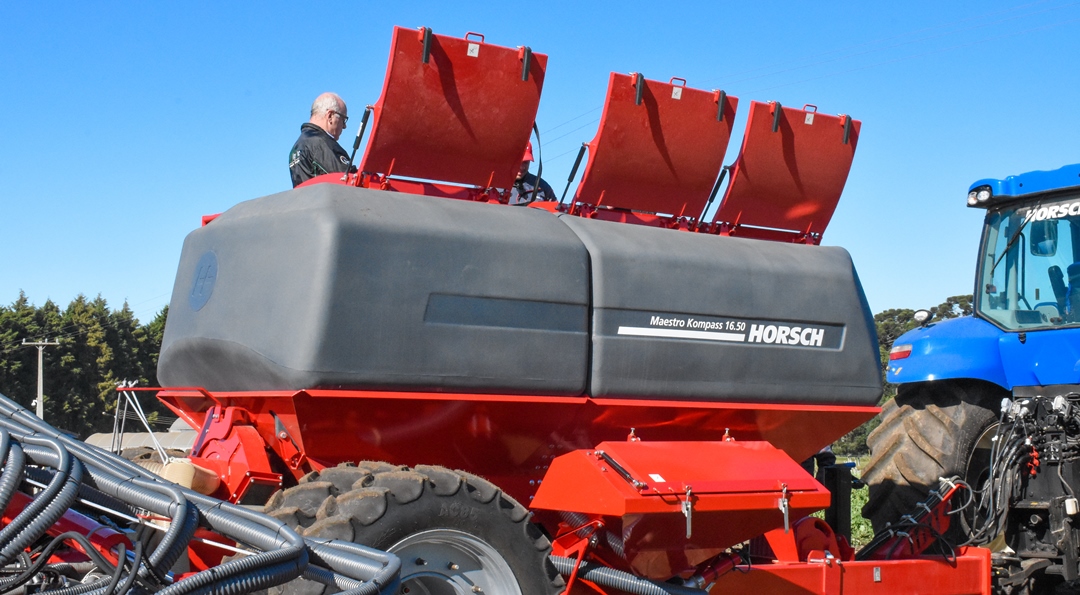
To support the weight of the machine in transport, the project included a rear axle with tire wheels, which in the standard version is simple in size 620/75-R26 and, as an option, the customer can purchase the machine with double wheels, specified as 320/85-R32. In this model there is no possibility of changing the wheel gauge. At the rear of the machine are the two sections of the planting bar, which articulate upwards and to the side, retracting to allow the reduction of the total width of the equipment.
HORSCH, in all its machines, offers the possibility of exchanging information between your machine and the tractor it is pulling, including sharing monitors, regardless of the brand. For complete accessibility, it is important that the customer informs the brand of their tractor, so that the appropriate electrical harness and plug-in comes with the purchase.
The technological development of this machine does not use mechanical drives, so all devices that require relative movement are controlled hydraulically or electrically. For hydraulic actuation, three remote control valves (VCRs) are required. One of them will be used to open or close the machine and to lower and raise it. The second serves to move the turbine that generates positive pressure for the fertilizer and seed circuit. The third will activate the turbine that generates the vacuum for the seed dosing mechanism. The tractor must have at least one valve with free return, for constant oil flow. In the communication between sensors and actuators and the operation of the monitor, a standard Isobus socket and connection cable are used. To activate the main seed doser, an electrical socket is used, Extra power system, which uses an electrical voltage of 12 volts with a current of 32 amps for machines with 14 lines, 40 amps for machines with 16 lines and 45 amps for machines which have 18 sowing lines.
The HORSCH Kompass model is offered to customers with up to 18 lines, with alternatives being machines with 14, 16 and 18 lines, with spacing of 45cm and 50cm, which the customer must choose at the time of purchase. Therefore, the customer can make six possible combinations, according to their crop implementation process.
As with other large machines in the HORSCH range, the pressure that the machine exerts on the lines is hydraulically controlled. Naturally, 150kgf is a result of the machine's own structure, but with this hydraulic assistance it is possible to reach a unit load of 330kgf per line, for cases where it is necessary to increase the cutting pressure and furrow opening.
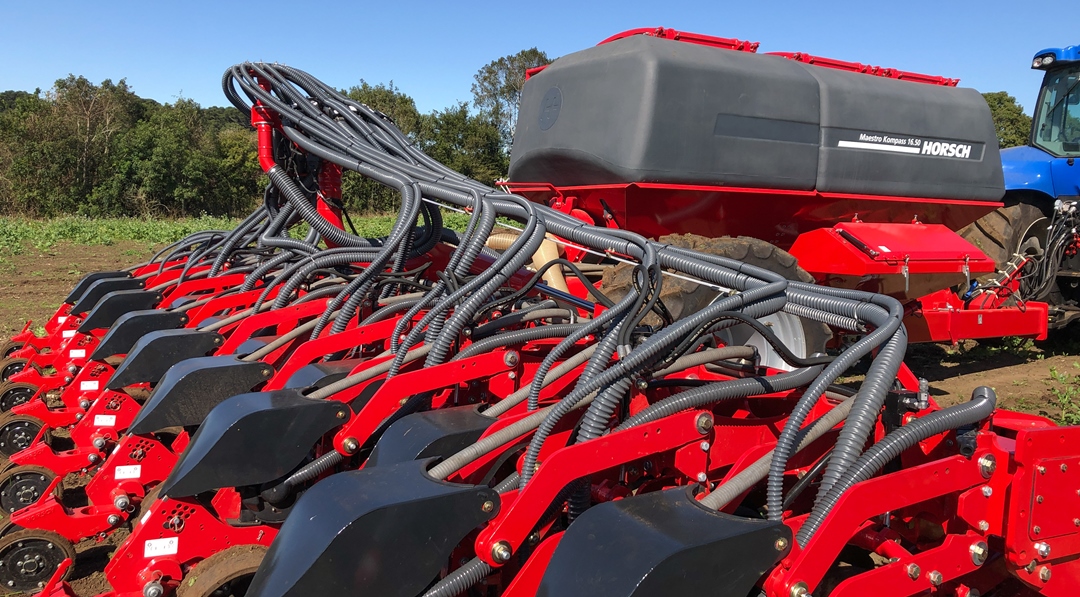
One of the great novelties and differences between this machine and the HORSCH models that we tested in previous editions is the straw cutting disc, which in addition to having double springs for cutting pressure, has a depth limiting wheel with position adjustment. , approach to the disc and pressure. The position of the disc can also be changed and it can be smooth-edged as standard or corrugated as an option, with a 20-inch diameter. It is next to the wheel, which helps hold the straw so that the disc can easily cut it. Furthermore, the planting lines are spaced apart from each other, which also helps with the flow of cut straw, preventing bushing.
Also as a new feature of this model compared to other HORSCH models, engineering has provided the fertilizer furrower with two adjustments, furrowing depth and angle of attack of the furrowing rod. The angle of attack can be changed using an oblong hole between the rod and its support.
The third new feature is the clamping wheel, an optional item, which serves to tighten the seed inside the furrow, after it has been positioned. This reduces the possibility of empty spaces remaining that hinder seed-soil contact and, therefore, the ease with which it absorbs moisture for germination and beginning of the emergence process. This wheel works just behind the seed duct and can be placed in the working position, removed or left up in the transport position.
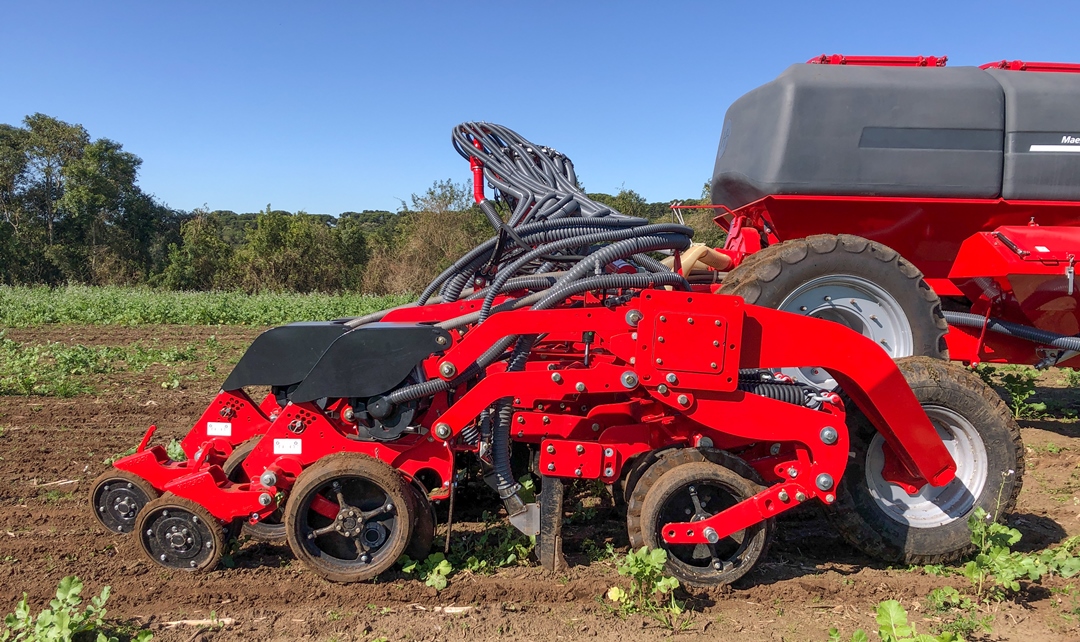
As this machine is pneumatic and uses an air flow, the positive pressure line is separate from the vacuum line, used in the seed dosing mechanism. A large turbine generates pressure for fertilizer and seed, sending the material by positive pressure through hoses that reach the seed and fertilizer dosers. Thick gray hoses come out of the fertilizer doser, and thin gray hoses come out of the seed doser. The air flow can be controlled via a damper and depends on the conditions of the fertilizing and seeding operation.
The fertilizer dosing and application process is carried out from the tank outlet, using a central dosing mechanism, of the fluted type, driven by an electric motor. There are several types of rotors available, achieving a wide range of fertilizer rates. At the bottom of the fertilizer tank there is a mixing agitator, which is activated only when the flow is not occurring, that is, when the machine is lifted for maneuvers or transport.
Once dosed, the flow follows through a thick hose, through the action of positive pressure, to a distribution tower, positioned in the center and above the planting and fertilization line, where it is distributed to each of the lines through smaller diameter hoses.
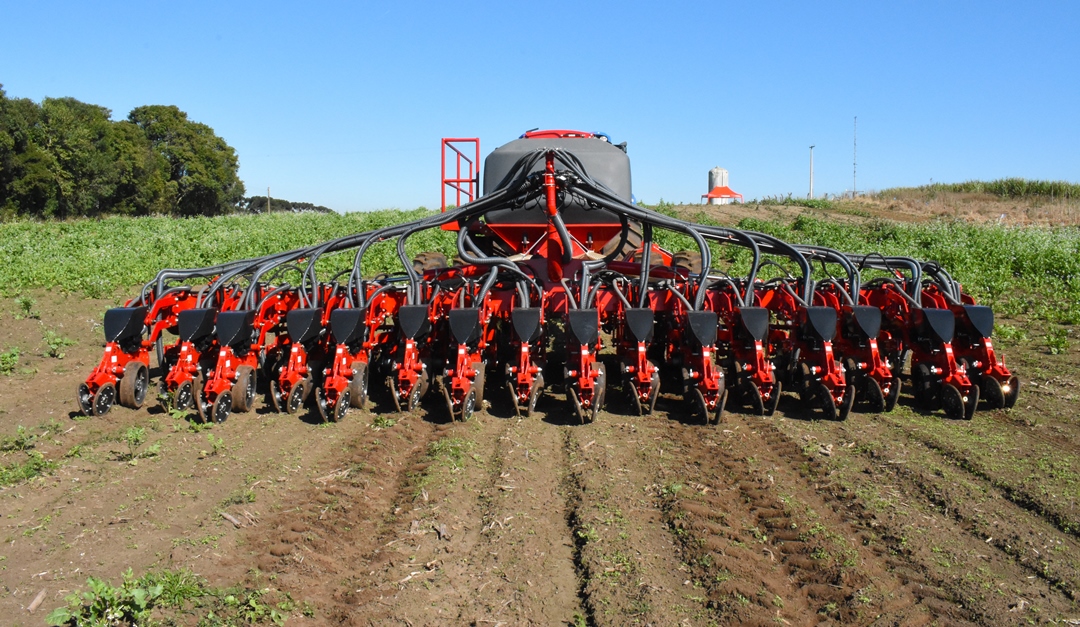
Next to the fertilizer outlet, there is a fertilizer presence sensor, which detects and warns the operator in the event of a flow interruption. As the system works with an air current, if there is a loss of pressure in the tank, a sensor detects this variation and informs the operator of this occurrence, so that something can be done to restore the pressure.
Something very interesting about HORSCH models is the possibility of calibrating the dosage before starting fertilization and sowing work. With the system that HORSCH uses, it is possible to check the weight using a small scale and a bag that comes with the machine. This bag is used to collect and with the scale it is possible to measure the amount of product being dosed and the value can be compared with the internal calculation made by the equipment and shown on the monitor. After repeating the procedure three times, the values are already the same as those shown on the monitor.
The sowing process begins in the main seed tank, with a capacity of three thousand liters, mainly for soybeans and corn, although a variety of discs are available that allow the implantation of other crops such as cotton, sorghum, etc. At the bottom there is a distributor that works in the MTS (Main Tank Supply) system, where the seeds from the deposit are distributed to the dosers individually.
At the back of the seed deposit between it and the planting line there is a turbine that serves to generate the vacuum, used in the process of seizing the seed from the disc and its individualization. Two hoses connect to the square tube, which forms the structure of the planting bar, and from there smaller hoses run directly to the dosers. At the ends of the line's structural tube there is a well-sealed lid, which is used for inspection and removal of dirt that has entered with the air current.

The system and components used in the Maestro Kompass are exactly the same as the system in the other Maestro Evolution and Duo machines. These AirVac dosers, with electrical drive and seed entrapment by negative pressure in a vertical disc, are an exclusive product from HORSCH and developed in Germany, representing a high-tech component. This model is a market differentiator, as it represents a high standard manufacturing and functioning element, in the smallest machine offered by HORSCH to the Brazilian market. The opening of the furrow and deposition of the seed is done using a system of double discs, which are controlled at the working depth by means of limiting wheels, which determine the depth at which the seed is deposited.
After the seeds are placed in their position in the furrow, two covering wheels do the work of giving the furrow a final finish, lightly compacting the soil over the seed and improving contact between them. The pressure with which this is done can be adjusted in five positions.

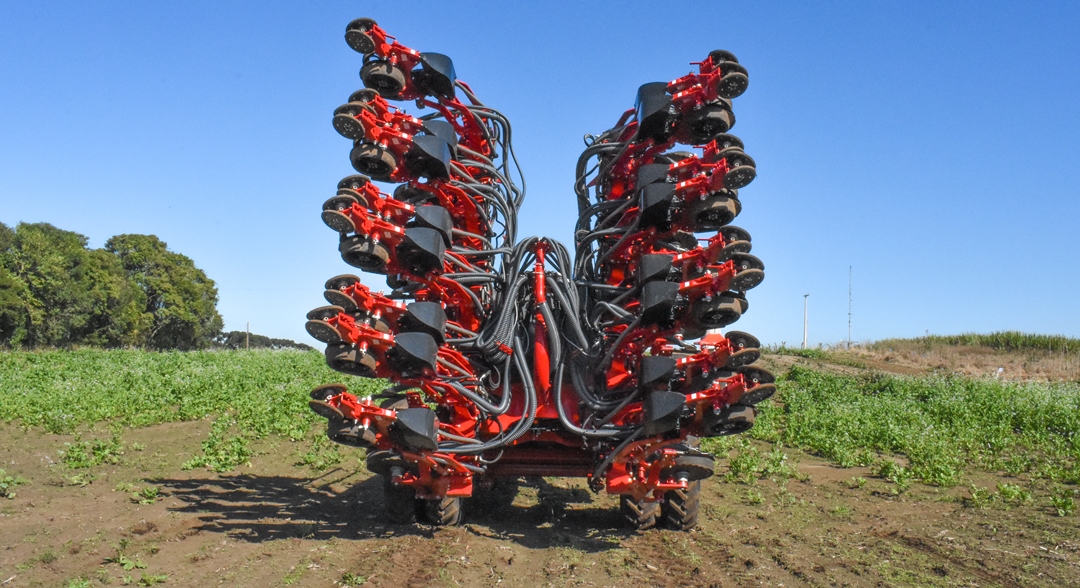
Opening and closing the machine is very simple and quick, done directly from the monitor, using the raise/lower function. First, the line is lifted from the ground and the articulation begins, which is done on two central points. In the final position, the two sections are at 90 degrees to the support plane. On this machine, unlike larger models, the lines are not placed over the tires, remaining behind them. The final width of the collected machine is 3,20 meters for transport. This width is strategic for complying with legislation and allows the machine to be transported without the need for trucks or accompanying scout vehicles. The opening process follows the sequence in reverse, first opening the sections and then placing them on the ground.
The machine is equipped with a side platform that provides circulation around the seed and fertilizer deposits, for inspection and monitoring of the supply process. Access to this platform is via a five-step ladder, the last one, and closest to the ground, being flexible as its sides are made of rubber. Both the steps and the platform have non-slip flooring and lateral support fittings.
For the field test, the conditions had already been prepared by the HORSCH field team. When we arrived, the machine was already attached to the tractor and fueled by trainee engineers, Daniel Savi and Fernando Pockrandt, who are agronomists, and by Alan Spiess, who is a mechanical engineer. The three showed a lot of knowledge about the machine, in the engineering and application aspects. From the marketing area, agricultural engineer Samuel Barros, a specialist in Product Marketing for the brand, supported us and showed us every detail of the machine, who has already accompanied us on other tests.
The tractor used for the test was New Holland, model T8.385. This tractor has a nominal power of 340hp and torque of 1.671Nm, in an 8,7-liter six-cylinder engine. Evidently, this 16-line machine does not need all this power to activate it, as the team estimates that, due to the soil conditions and the machine's constitution, less than 250 hp would be sufficient.
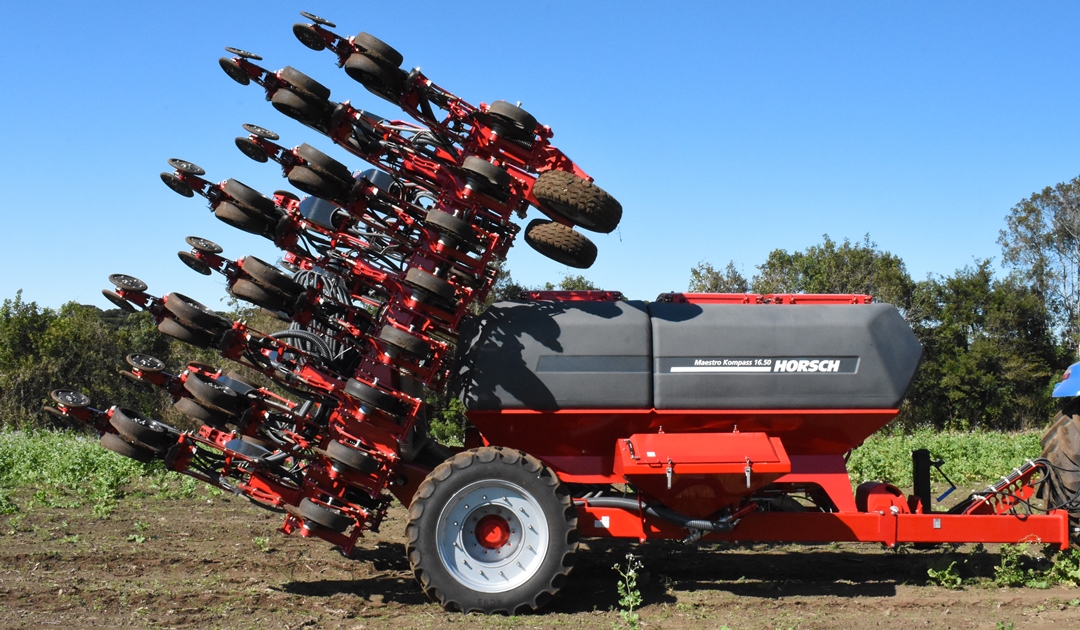
We started the test, understanding the machine's opening and closing mode and verifying that the time for complete closing and opening is approximately 30 to 35 seconds, in each operation.
During the field test, in which fertilization and sowing work was carried out in a plot where there was a predominance of forage turnip cover, the Touch800 terminal showed us an average pressure applied to the line of 150kgf. The average operating speed was 6km/h and the engine angular speed was around 1.560rpm. The operation we programmed for the test was soybean sowing, for a population of 240 thousand soybean seeds per hectare, which we calculated based on the distance between rows, a quantity of 12 seeds per linear meter and a spacing between seeds of 8,3cm .
After passing the machine, we opened several sections of the furrow and checked the quality of the longitudinal distribution and the presence of acceptable spacings, considering the sowing quality to be very good. From inside the cabin, it was possible to see in the terminal the quantity of seeds dropped per line and that we would be notified if the seed flow was interrupted and on which line this had happened. With the numbering of all lines, it would be easy to make corrections, if necessary.

Although the machine offers several options, the one we tested had one that many customers prefer. This is the small seed distribution system. This machine offers the possibility that, along with fertilization and sowing, the producer can choose to distribute small seeds or other granulated products that can be distributed along with this operation. A 320-liter tank, placed on the side of the machine, stores this product, which is taken by air current to the same support as the fertilizer tower, via a separate hose, using a smaller tower. The doser used is electrically driven worm screw. The product, generally small seeds, is deposited behind the fertilizer line using a deflector, which, if positioned vertically, allows the product to fall in a more concentrated manner and, if raised, provides greater dispersion.
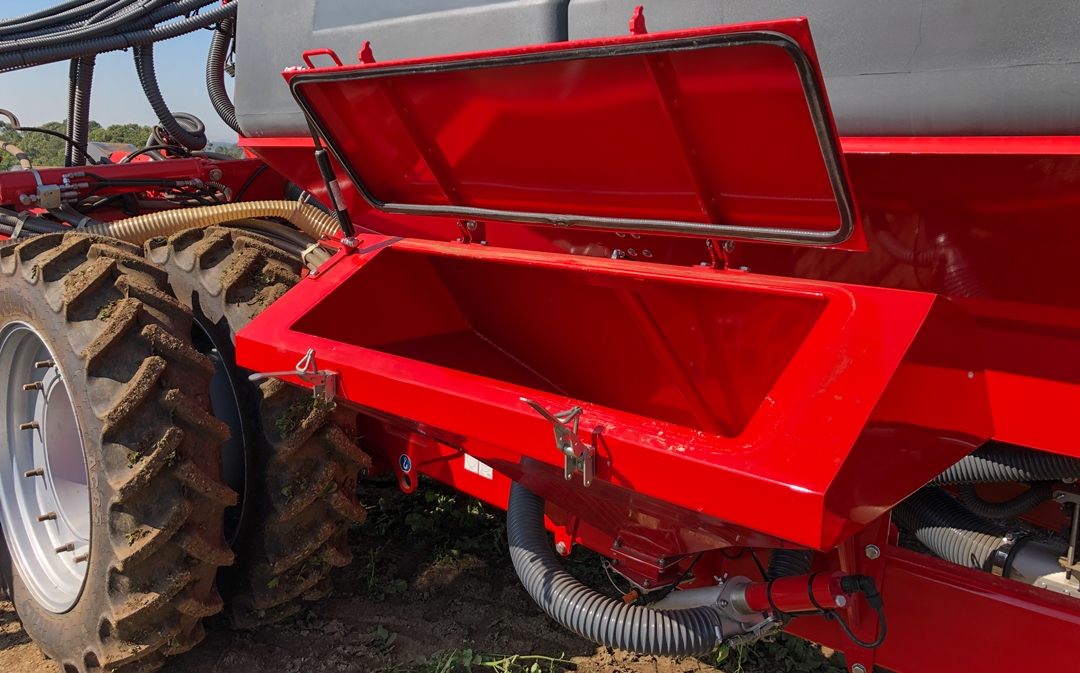
Several positive considerations could be made regarding this machine model. It is a technologically developed machine, and this particular model went through a process of tropicalization and adaptation to the nationally particular process of our direct planting in straw.
It is also worth highlighting the HORSCH system that allows the user to simulate and diagnose the distribution quality of fertilizer and seed, before starting the operation. Planting can be simulated by checking the coefficient of variation, all through the tractor's monitor, even when the machine is stopped. Seed dosage control can also be carried out in operation via the E-Manager.
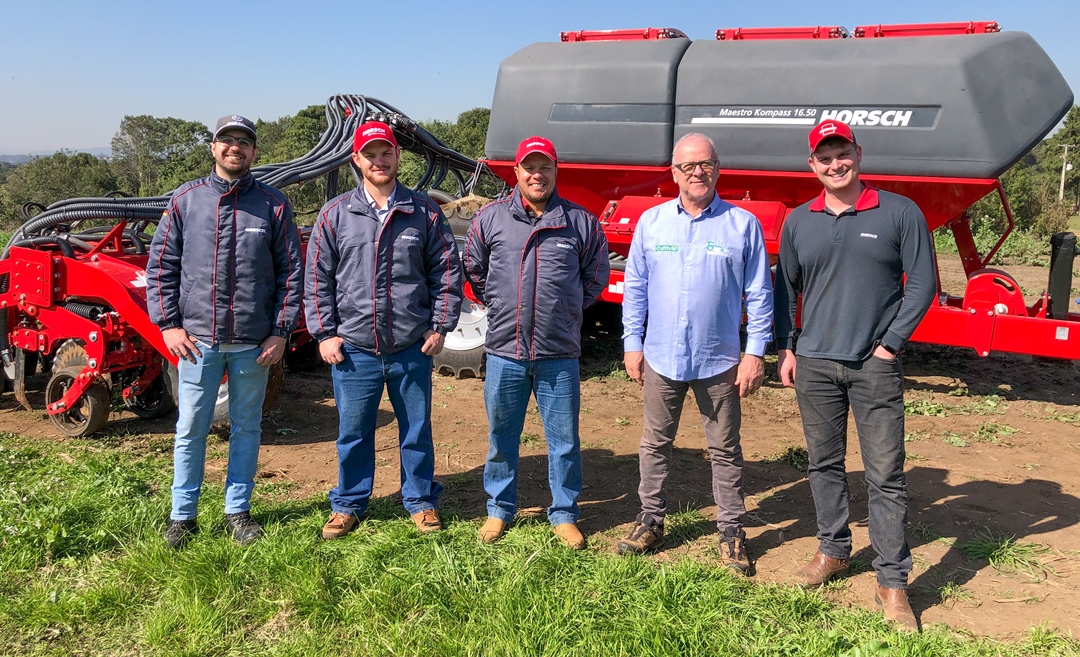
It is also worth highlighting the effort made by the manufacturer to increase autonomy, by placing the largest seed deposit on the market in the category.
Finally, it is worth highlighting the differences included in this machine, aimed at direct planting with the presence of a large amount of straw, specifically the cutting disc and the cutting control and support wheels. We also highlight the new fertilizer furrowing rod, developed here in Brazil.
José Fernando Schlosser and
Henrique Eguilhor Rodrigues,
Nema Agrotechnology Laboratory – UFSM

Receive the latest agriculture news by email
Reducing productivity and responsible for the production of mycotoxins that are harmful to human health, FHB is an aggressive fungal disease in wheat crops.
Since the 2009/10 harvest, soybean crops have manifested symptoms such as wrinkling of the leaf blade, thickening of veins, blackening of leaves, abortion of flowers and pods, poor grain formation and oversprouting. Among the hypotheses to explain this anomaly is the probable potassium deficiency